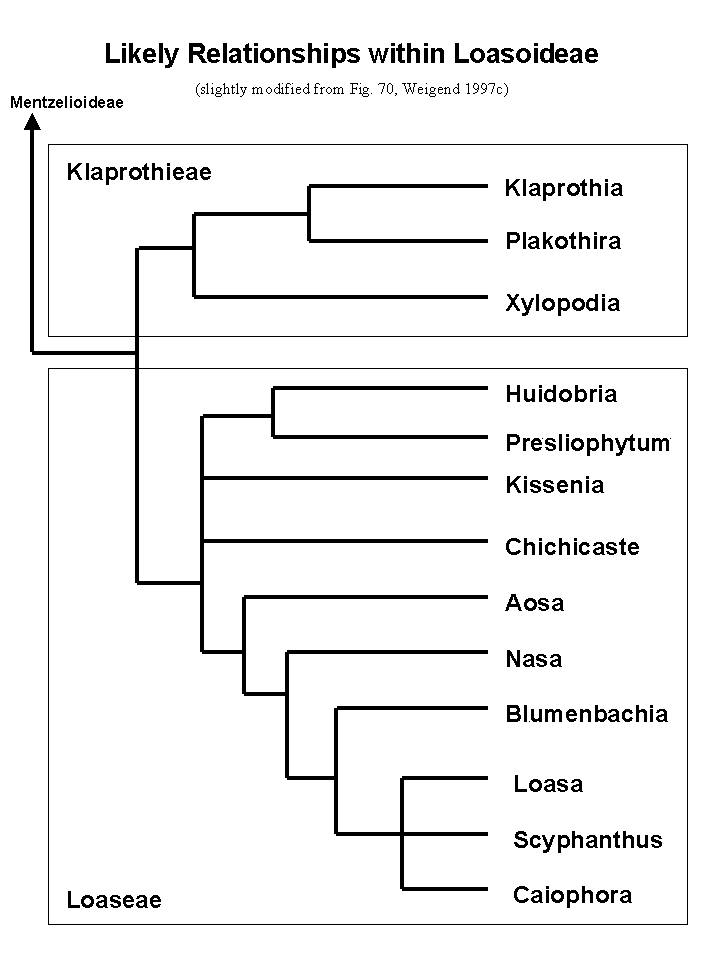|
|
genera |
Classification |
entities |
|
Pictures |
|
The Loasaceae web page
by Maximilian
Weigend
Loasaceae are a striking plant family, not least because of their often extremely intricate floral morphology and their frequently very painful stinging hairs. Little progress, however, has been made in the knowledge of this family since the brilliant revision by Urban & Gilg in 1900, i.e. rather exactly 100 years ago. In the meantime a lot of new specimens have accumulated in the herbaria and Urban & Gilg’s taxonomical and systematical conclusions can now be tested on the basis of much more and generally very much better material. However, the strongest impetus for new insights into Loasaceae came from extensive field studies, carried out in the past few years, primarily in northern South America. Due to field data, cultivation of many taxa and a revision of much herbarium material of the subfamily Loasoideae new insights have been gained. A large number of new species, especially in the Andes, have been discovered. Xylopodia, a new genus, which had not been previously collected, was encountered in Northern Peru and described. It proved to be intermediate in many crucial characters and generally of much phylogenetic relevance, indicating possible evolutionary trends in the subfamily Loasoideae. The taxonomical re-arrangements are based on seed surface, inflorescence, staminodial, petal and sepals morphology, cytology, habit (including leaf morphology and underground structures) and distribution and ecology.
A largely new classification esp. for the subfamily Loasoideae has recently been published. A comprehensive overview over these changes is given in: M. Weigend: Nasa and the conquest of South America (1997), which is available in many major herbaria (ca. 60 copies). However, while validly published, it is not fully accessible. Therefore the crucial points of this study are here made generally available. The new entities are based on a wide range of characters and some of the re-arrangements are also supported by the extensive data on iridoid distributions in the family (Mueller & Weigend 1998, 1999, Mueller et al. 1998, 1999).
Attempts to provide a molecular phylogeny of Loasaceae, sampling a limited number of taxa, have been made in the past few years (Hempel et al. 1995, Hempel & Jansen 1996, Moody & Hufford 1999). Moody & Hufford (within the limits of their sampling) found very good support for the genera of Loasoideae as described by Weigend in 1997. However, the respective molecular phylogenies are highly divergent in two key issues. Hempel found the genus Eucnide to be derived from within Mentzelia and the Gronoviaceae as isolated within the family, whereas Moody & Hufford found the genus Eucnide to be sister to the rest of Gronoviaceae and Loasaceae (i.e. the most basal taxon within the group) and the "Gronoviaceae" as sister to Mentzelia. Morphology certainly seems to be more consistent with the results of Hempel & Jansen, but more detailed molecular data may ultimately show that the relationships as indicated by Moody & Hufford are correct and that their disagreement with morphological data is due to extensive homoplasy. While a reliable molecular phylogeny is wanting I suggest to adhere to a morphological classification.
This web site is supposed to provide all relevant data on the family, including the new taxa, generic synonyms, short descriptions and a key. The vast majority of the relevant references are listed, but this listing is by no means exhaustive. Lists of all infrageneric entities and ultimately of the species will be provided in the future. The web site will be regularly updated and all newly available data will be included.
author M. Weigend, web design K. I. Weigend.
photographs on this page by M. Weigend; from upper left to
bottom right:
Gronovia scandens
Mentzelia lindleyana
Plakothira parviflora
Presliophytum arequipensis
Nasa picta
Nasa grandiflora
Caiophora sepiaria
Caiophora buraeavii (floral scale)
Proposed
classification of Loasaceae / Gronoviaceae
(slightly modified from Fig. 73 in Weigend 1997c).
|
|
|||
|
|
|
||
|
|
|
||
| Klaprothia
2
spp
Plakothira 3 spp Xylopodia 1 spp |
Aosa
7
spp
Blumenbachia 12 spp Caiophora 56 spp Chichicaste 1 sp Huidobria 2 spp Kissenia 2 spp Loasa 36 spp Nasa 100 spp Presliophytum 3 spp Scyphanthus 1-2 spp |
Eucnide
12
spp
Mentzelia 80 spp Schismocarpus 1 sp |
|
|
|
|||
|
|
|
||
| Cevallia
1
sp
Fuertesia 1 spp Gronovia 2 spp |
Petalonyx 5 spp | ||
